The Intel Core i7-7700K (91W) Review: The New Out-of-the-box Performance Champion
by Ian Cutress on January 3, 2017 12:02 PM ESTOffice Performance
The dynamics of CPU Turbo modes, both Intel and AMD, can cause concern during environments with a variable threaded workload. There is also an added issue of the motherboard remaining consistent, depending on how the motherboard manufacturer wants to add in their own boosting technologies over the ones that Intel would prefer they used. In order to remain consistent, we implement an OS-level unique high performance mode on all the CPUs we test which should override any motherboard manufacturer performance mode.
All of our benchmark results can also be found in our benchmark engine, Bench.
Dolphin Benchmark: link
Many emulators are often bound by single thread CPU performance, and general reports tended to suggest that Haswell provided a significant boost to emulator performance. This benchmark runs a Wii program that raytraces a complex 3D scene inside the Dolphin Wii emulator. Performance on this benchmark is a good proxy of the speed of Dolphin CPU emulation, which is an intensive single core task using most aspects of a CPU. Results are given in minutes, where the Wii itself scores 17.53 minutes.
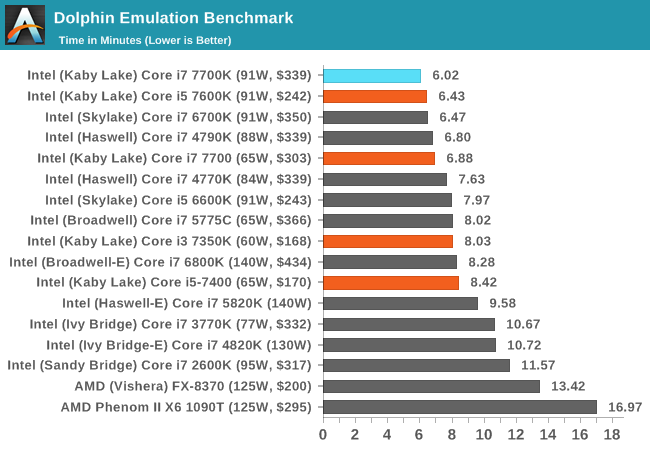
As shown by the data, the i7-7700K takes the top spot. At stock it edges out an overclocked Core i7-4790K at 4.7 GHz, which is no mean feat. Dolphin is all about high frequency and IPC, which the i7-7700K has the best of both.
WinRAR 5.0.1: link
Our WinRAR test from 2013 is updated to the latest version of WinRAR at the start of 2014. We compress a set of 2867 files across 320 folders totaling 1.52 GB in size – 95% of these files are small typical website files, and the rest (90% of the size) are small 30 second 720p videos.
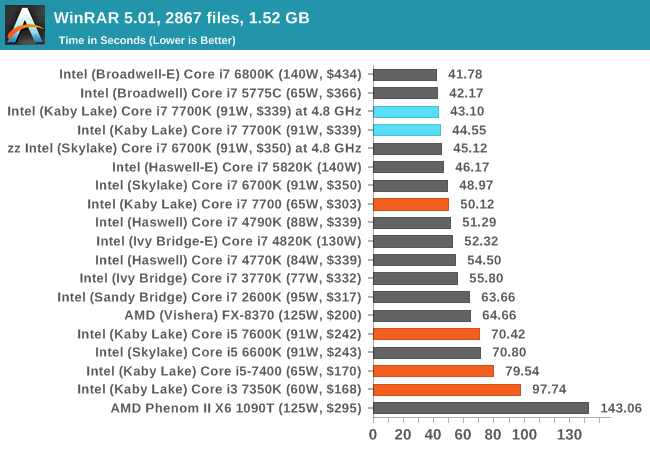
WinRAR is more geared towards a variable threaded environment but also memory speed. While two channels of DDR4-2400 does well for the Core i7-7700K, to the point where it beats the 6-core i7-5930K, anything with eDRAM (i7-5775C) and the higher end quad channel processors with up to 10 cores do win out. But at $1700 for 10-core, the Kaby Lake CPU does well – the only processor that beats it in its price range is that eDRAM-based i7 part.
3D Particle Movement v2
3DPM is a self-penned benchmark, taking basic 3D movement algorithms used in Brownian Motion simulations and testing them for speed. High floating point performance, MHz and IPC wins the day. This is the second variant of this benchmark, fixing for false sharing in the first version, and lending itself to better multithreaded performance.
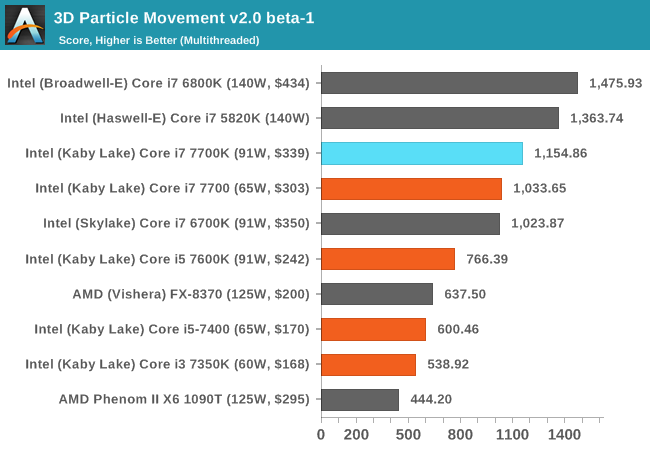
3DPMv2 is still new, so we don’t have too many results for it so far, but it hits the top of the mainstream processor stack as was perhaps to be expected. It scores almost double an FX-8370, showing how far Intel’s mainstream has come from AMD’s old CPUs, but the Core i7-7700K matches up to just over double the Core i3-7350K, as it has double the cores/threads and slightly more frequency.
SYSMark 2014
Engineered by BAPco (to which Intel is a consortium member), this set of tests are designed to be an office/data/media/financial range of tests using common well-known CAD, image editing, web browsing and other tools to put out a score, where a score of 1000 is attributed to an old Core i3 using a mechanical harddrive. Here we report the overall score, however the test breakdowns can be found in Bench.

Because SYSMark is a variety of tests that rely on response and throughput, the Core i7-7700K hits the mix just right and scores higher than even a 10-core Core i7 Extreme part launched last year, as well as a highly overclocked Devil’s Canyon. Aside from the Core i5, the 7700K does well in price/performance here.
Web Benchmarks
On the lower end processors, general usability is a big factor of experience, especially as we move into the HTML5 era of web browsing. For our web benchmarks, we take well known tests with Chrome as installed by SYSMark as a consistent browser.
Mozilla Kraken 1.1
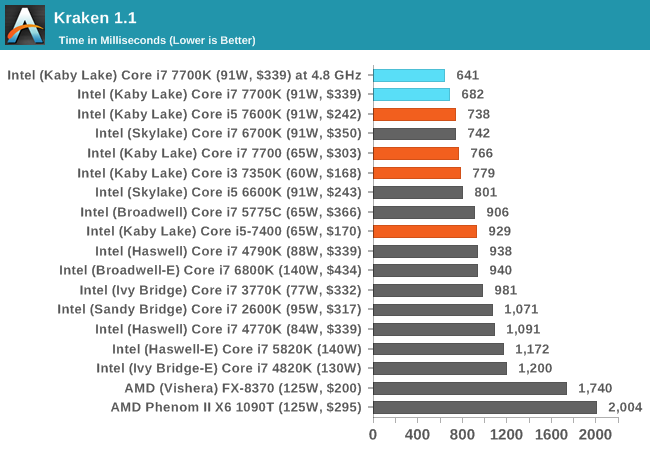
Google Octane v2
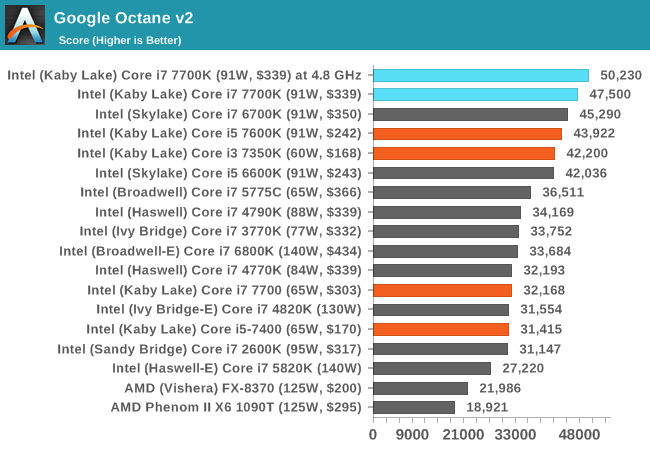










125 Comments
View All Comments
Ian Cutress - Wednesday, January 4, 2017 - link
The boards will default to DDR4-2133 as a base memory frequency, regardless of processor. JEDEC has profiles for 2133 and 2400, and Kaby Lake is compatible with the JEDEC DDR4-2400 profile. So in order to achieve this, we use kits that offer DDR4-2400 JEDEC memory profiles via XMP. Enable XMP, and you're at the frequency that's officially supported by the processor, which is JEDEC. Out of the box usually refers to the BIOS, as we tend to eschew special 'media' BIOSes that might adjust certain performance parameters.ccdrop - Tuesday, January 3, 2017 - link
I just wanted to give you guys a super big THANK YOU! for testing under Windows 7 64-bit SP1, now I can be excited about the 7700k again!My big worry was that the 7700k was going to be a useless upgrade from my 2600K due to the whole "not officially support" drama as I flat have no interest in windows 10 (Please don't reply with Pro-10 comments I will never read them as I will never check these comments again I am just here to say thank you, along with the fact I have a laundry list about a mile long as to why I despise 10, I have thoroughly tested it for my use cases and it is a very solid downgrade. I am not a gamer so do it for the games is meaningless. As for security, my main workstation isn't attached to any networks and if you have local access to the system 10 is no better then 7, finally as for doing it for the "new features" just because you know new features are new... I will wait and see if the 7700k really runs 10~20% better on Windows 10 than windows 7 WITH MY SOFTWARE not games or things I don't use, then I'll switch. However as of now on my current hardware Windows 10 runs about 10~20% slower then windows 7 with my software, and is vastly more prone to errors and workflow interruptions.)
negusp - Thursday, January 5, 2017 - link
stfu, it is a pretty useless upgrade. 10-20% over a 2600k is nothing to be excited about.wait for Ryzen or Cannonlake. if you think your 2600k is anywhere near obsolete you have to be kidding me.
fm13 - Thursday, January 5, 2017 - link
I'm still using my i7 860 which is still OK at stock frequencies.The_Assimilator - Tuesday, January 3, 2017 - link
AnandTech reviews that are on time, what sorcery is this? I sincerely hope to see more of it this year!just4U - Wednesday, January 4, 2017 - link
I do not recall Ian ever being late to the party on his reviews...Thatguy97 - Wednesday, January 4, 2017 - link
Ryan is always lateRemember Fiji? And the "on the way" gtx 950 review?
Toss3 - Tuesday, January 3, 2017 - link
"In most of our benchmarks, the results are clear: a stock Core i7-7700K beat our overclocked Core i7-4790K in practically every CPU-based test (Our GPU tests showed little change)."Wait the 4790K was overclocked? You didn't mention the clockspeed anywhere. And how can a 5820K be faster than a 6800K (Grid: Autosport on MSI R9 290X)? You really need to let your readers know what speeds these CPUs are running at.
Thatguy97 - Tuesday, January 3, 2017 - link
No fucking increase in IPCDamn we need some competition bad and shame on anandtech for not ragging on Intel for lack of innovation
ThomasS31 - Tuesday, January 3, 2017 - link
Thanks... though it would be time to upgrade the GPU part to at least a GTX1080 or more like a TXP... I see on other tests, that those, especially the TXP shows some differences in high end gpus more. GTX980 is limiting these days too heavy.